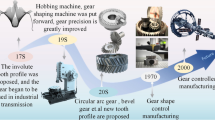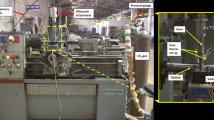Abstract
Due to flank deformation induced by the heat treatment and manufacturing error in previous cutting, the lapping position on the gear surface would deviate from the theoretical ones, which would lead to the reduction of lapping quality. In this paper, the lapping adjustment method of the actual surface of hypoid gear is proposed. Firstly, a bi-cubic B-spline surface is applied to reconstruct and densify the meshing flanks based on the measured tooth flank form data. Secondly, a discrete tooth contact analysis (DTCA) approach is introduced to calculate the real lapping position. A dynamic two-dimension golden section iteration algorithm is used to obtain the exact meshing location. In the end, a hypoid gear set after heat treatment is selected to perform the rolling test. The results from the lapping position calculation method is according with the rolling test results, by which the effectiveness and feasibility of the proposed algorithm are confirmed.












Similar content being viewed by others
References
Karpuschewski B, Knoche HJ, Hipke M (2008) Gear finishing by abrasive processes. CIRP Ann Manuf Technol 57(2):621–640. https://doi.org/10.1016/j.cirp.2008.09.002
Jiang Q, Gosselin C, Masseth J (2008) Simulation of hypoid gear lapping. ASME J Mech Des 130(11):112601-1–10. https://doi.org/10.1115/1.2976453
Jiang Q, Gosselin C, Masseth J (2009) Computer-aided machine setting for lapping optimization. ASME J Mech Des 131(3):031003-1–8. https://doi.org/10.1115/1.3066548
Kazunori H, Masahiko N, Toshinori M et al (2004) gear finishing by lapping and its effect. JSME Symp Motion Power Transm 2004:428–431. https://doi.org/10.1299/jsmempt.2004.428
Masseth J, Kolivand M (2007) Lapping and superfinishing effects on hypoid gears surface finishing and transmission errors. In: Proceedings of the ASME 2007 international design engineering technical conferences, Las Vegas, Nevada, USA. https://doi.org/10.1115/DETC2007-34010
Wei BY, Deng XZ, Fang ZD (2009) The lapping mechanism of hypoid gears. J Mater Process Technol 209(6):3001–3008. https://doi.org/10.1016/j.jmatprotec.2008.07.005
Schlecht B, Rudolph F, Schumann S (2017) Experimental studies and simulation of hypoid gear lapping. Forsch Ingenieurwes 81:95–100. https://doi.org/10.1007/s10010-017-0214-4
Takeda R, Komori M, Nishino T, Kimura Y et al (2014) Performance analysis of generated hypoid gear based on measured tooth flank form data. Mech Mach Theory 72:1–16. https://doi.org/10.1016/j.mechmachtheory.2013.09.008
Rudolph F, Schumann S, Schlecht B (2019) Consideration of solid particles in a gear lapping simulation. Forsch Ingenieurwes 83(3):801–808. https://doi.org/10.1007/s10010-019-00342-9
Li G, Wan Z, Kubo A (2016) The modeling approach of digital real tooth surfaces of hypoid gears based on non-geometric-feature segmentation and interpolation algorithm. Int J Precis Eng Manuf 17(3):281–292. https://doi.org/10.1007/s12541-016-0036-6
Li G, Zhonghou W, Aizoh K (2017) Error-sensitivity analysis for hypoid gears using a real tooth surface contact model. Proc Inst Mech Eng Part C J Mech Eng Sci 231(3):507–521. https://doi.org/10.1177/0954496212441752
Li G (2017) Study of contact mechanics and dynamic performance of hypoid gears. University of Shanghai for Science and Technology, Shanghai, pp 37–127 (in Chinese)
Junhui Z, Zongde F, Cheng W (2009) Digital simulation of spiral bevel gears’ real tooth surfaces based on non-uniform rational B-spline. J Aerosp Power 24(7):1672–1676 (in Chinese)
Jinfu Du, Fang Z (2016) An active tooth surface design methodology for face-hobbed hypoid gears based on measuring coordinates. Mech Mach Theory 99:140–154. https://doi.org/10.1016/j.mechmachtheory.2016.01.002
Acknowledgements
Financial assistance was provided by the National Natural Science Foundation of China (52275054) of Jianjun Yang and Key Scientific and Technological Project of Henan Province (192102210057) of Jianjun Yang.
Author information
Authors and Affiliations
Corresponding author
Ethics declarations
Conflict of interest
The authors declare that they have no competing financial interests or conflicts of interests that could influence this work.
Additional information
Technical Editor: Zilda de Castro Silveira.
Publisher's Note
Springer Nature remains neutral with regard to jurisdictional claims in published maps and institutional affiliations.
Rights and permissions
Springer Nature or its licensor (e.g. a society or other partner) holds exclusive rights to this article under a publishing agreement with the author(s) or other rightsholder(s); author self-archiving of the accepted manuscript version of this article is solely governed by the terms of such publishing agreement and applicable law.
About this article
Cite this article
Wang, S., Yang, J., Li, B. et al. Lapping adjustment method for actual surface of hypoid gears. J Braz. Soc. Mech. Sci. Eng. 45, 122 (2023). https://doi.org/10.1007/s40430-023-04027-x
Received:
Accepted:
Published:
DOI: https://doi.org/10.1007/s40430-023-04027-x




